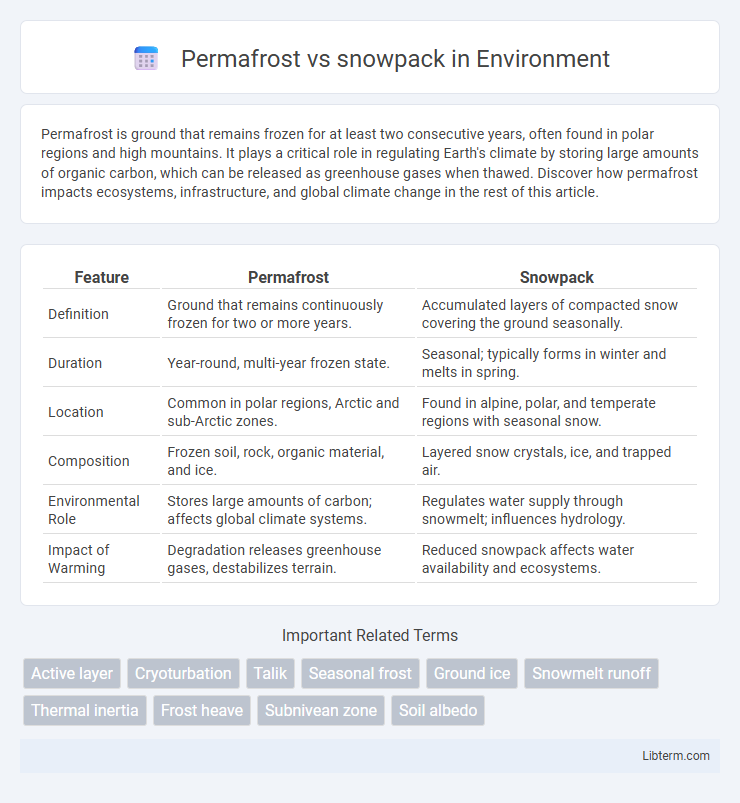Permafrost is ground that remains frozen for at least two consecutive years, often found in polar regions and high mountains. It plays a critical role in regulating Earth's climate by storing large amounts of organic carbon, which can be released as greenhouse gases when thawed. Discover how permafrost impacts ecosystems, infrastructure, and global climate change in the rest of this article.
Table of Comparison
| Feature | Permafrost | Snowpack |
|---|---|---|
| Definition | Ground that remains continuously frozen for two or more years. | Accumulated layers of compacted snow covering the ground seasonally. |
| Duration | Year-round, multi-year frozen state. | Seasonal; typically forms in winter and melts in spring. |
| Location | Common in polar regions, Arctic and sub-Arctic zones. | Found in alpine, polar, and temperate regions with seasonal snow. |
| Composition | Frozen soil, rock, organic material, and ice. | Layered snow crystals, ice, and trapped air. |
| Environmental Role | Stores large amounts of carbon; affects global climate systems. | Regulates water supply through snowmelt; influences hydrology. |
| Impact of Warming | Degradation releases greenhouse gases, destabilizes terrain. | Reduced snowpack affects water availability and ecosystems. |
Understanding Permafrost and Snowpack
Permafrost is a layer of soil or rock that remains continuously frozen for at least two consecutive years, storing vast amounts of organic carbon and influencing global climate systems. Snowpack refers to the accumulation of seasonal snowfall that insulates the ground and regulates soil moisture, playing a critical role in hydrological cycles. Understanding the interaction between permafrost and snowpack is essential for predicting ecosystem stability, water resources, and the impacts of climate change in cold regions.
Formation Processes of Permafrost vs Snowpack
Permafrost forms through prolonged freezing of soil or rock, typically found in polar regions where ground temperature remains below 0degC for at least two consecutive years, allowing ice to accumulate and stabilize underground layers. Snowpack develops from successive snowfall layers that compact and bond over a single winter season, influenced by temperature fluctuations, wind, and solar radiation affecting density and metamorphism. The key distinction lies in permafrost's enduring frozen state formed over decades or millennia versus the transient, seasonal nature of snowpack derived from atmospheric precipitation.
Geographic Distribution Differences
Permafrost primarily occurs in high-latitude regions such as Siberia, Alaska, and northern Canada, where ground temperatures remain below freezing for at least two consecutive years. Snowpack, however, is found across a broader range of climates, from temperate mountain ranges like the Rockies and the Alps to polar environments, accumulating seasonally during winter months. The geographic distribution of permafrost is more static and continuous, while snowpack distribution is dynamic and varies annually based on precipitation and temperature patterns.
Physical Characteristics Comparison
Permafrost consists of permanently frozen ground that remains below 0degC for at least two consecutive years, characterized by a solid ice-rich layer mixed with soil and rock, often extending several meters deep. Snowpack forms as seasonal accumulations of layered snow with variable density and moisture content, typically melting in warmer months and affecting surface insulation and hydrology. The key physical difference lies in permafrost's stability and persistence as a frozen substrate, versus snowpack's transient, dynamic nature influenced by temperature fluctuations and snowfall patterns.
Seasonal Dynamics and Changes
Permafrost and snowpack exhibit distinct seasonal dynamics that significantly impact Arctic ecosystems and climate feedbacks. Permafrost remains frozen year-round but experiences active layer thawing and refreezing cycles, with thickness varying seasonally, whereas snowpack accumulates in winter and melts during spring, influencing soil insulation and moisture availability. Changes in snowpack duration and depth due to warming temperatures directly affect permafrost thermal regimes, accelerating thaw rates and altering landscape stability.
Impact on Local Ecosystems
Permafrost stabilizes soil and regulates hydrology, supporting boreal forests and tundra ecosystems, while snowpack influences seasonal water availability and insulating vegetation during winter. Melting permafrost releases greenhouse gases, disrupting nutrient cycles and altering habitat conditions, whereas fluctuating snowpack affects freshwater resources and plant phenology. Both permafrost degradation and reduced snowpack threaten biodiversity, soil integrity, and carbon storage in cold region ecosystems.
Climate Change Effects on Permafrost and Snowpack
Permafrost degradation due to rising global temperatures causes ground instability and releases significant amounts of methane, a potent greenhouse gas that accelerates climate change. Snowpack reductions decrease seasonal water availability, impacting ecosystems and human water resources, while also altering surface albedo and enhancing regional warming. The interplay between thawing permafrost and diminishing snowpack intensifies feedback loops, exacerbating climate change effects in polar and alpine regions.
Role in Hydrological Cycles
Permafrost acts as a critical reservoir in the hydrological cycle by storing frozen groundwater and regulating seasonal meltwater release, influencing groundwater flow and surface water systems. Snowpack accumulates winter precipitation and gradually releases meltwater in spring and summer, sustaining rivers, lakes, and ecosystems during dry periods. Together, permafrost and snowpack control water availability, timing, and distribution in cold-region hydrology, impacting global water cycles and climate feedbacks.
Challenges in Monitoring and Research
Permafrost and snowpack present distinct challenges in monitoring due to their varying spatial and temporal dynamics, with permafrost requiring long-term subsurface temperature measurements and snowpack demanding accurate assessment of depth, density, and water content. Remote sensing technologies face limitations in penetration depth for permafrost and signal attenuation in snowpack, complicating data acquisition. Research efforts must address heterogeneity in permafrost composition and rapid snowpack changes caused by climatic fluctuations to improve prediction models and climate impact assessments.
Human Impacts and Environmental Concerns
Permafrost degradation releases significant amounts of greenhouse gases like methane and carbon dioxide, accelerating climate change and threatening infrastructure stability in Arctic communities. Snowpack reduction alters freshwater availability, disrupting agriculture, drinking water supplies, and hydroelectric power generation for millions of people. Both permafrost thaw and snowpack loss exacerbate ecosystem imbalances, increasing soil erosion, landslides, and habitat loss that impact biodiversity and human livelihoods.
Permafrost Infographic

 libterm.com
libterm.com